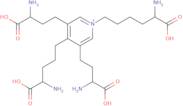Informations sur le produit
- 4-[(4S)-4-Amino-4-carboxybutyl]-1-[(5S)-5-amino-5-carboxypentyl]-3,5-bis[(3S)-3-amino-3-carboxypropyl]pyridinium
- 6-[4-(4-Amino-4-Carboxybutyl)-3,5-Bis(3-Amino-3-Carboxypropyl)Pyridinium-1-Yl]Norleucine
- Desmosine (amino acid)
- Pyridinium, 4-(4-amino-4-carboxybutyl)-1-(5-amino-5-carboxypentyl)-3,5-bis(3-amino-3-carboxypropyl)-
- Pyridinium, 4-(4-amino-4-carboxybutyl)-1-(5-amino-5-carboxypentyl)-3,5-bis(3-amino-3-carboxypropyl)- (VAN)
- Pyridinium, 4-[(4S)-4-amino-4-carboxybutyl]-1-[(5S)-5-amino-5-carboxypentyl]-3,5-bis[(3S)-3-amino-3-carboxypropyl]-
Disulfide bonds are covalent bonds that form between the sulfur atoms of two cysteine residues. Disulfide bonds are essential for the structural integrity of proteins, such as elastin and collagen. Desmosine is a compound that contains two cysteine molecules in a single molecule. The structure of desmosine is similar to that of a peptide bond, except one amino acid has been replaced by two sulfhydryl groups (SH). Desmosine is an important component in the formation of disulfide bonds because it can be used to replace one protein with two SH groups, which then react with each other. This reaction is required for the formation of disulfide bonds in proteins.





